| If you do NOT see the Table of Contents frame to the left of this page, then Click here to open 'USArmyGermany' frameset |
||||||||||||||||||||
|
319th ASA Battalion (Corps) |
||||||||||||||||||||
|
|
||||||||||||||||||||
|
||||||||||||||||||||
|
|
||||||||||||||||||||
| 307th Army Security Agency Battalion | ||||||||||||||||||||
| 307th Communications Reconnaissance Battalion | ||||||||||||||||||||
| 1951 - 1956 | ||||||||||||||||||||
| (Source: A Short History of the 319th US Army Security Agency Battalion (Corps), 24 December 1951 - 1 June 1963; submitted by Len Bittner) | ||||||||||||||||||||
| The 307th Communications Reconnaissance Battalion was activated on 27 December 1951, assigned to the Chief, US Army Security Agency, Europe and attached to the Commander in Chief Europe for logistical and disciplinary control. The first Battalion Commander was Lt Col Samuel R. Ross, Arty. | ||||||||||||||||||||
|
||||||||||||||||||||
| From activation until the end of the 1952 Fiscal Year, the battalion enjoyed the record of having only one motor vehicle accident. In November 1952, members of the battalion unofficially adopted a German Orphanage consisting of about thirty children between the ages of five and twelve years old. All personnel joined hands to raise the funds and gather clothing and equipment needed by the orphanage. A Thanksgiving dinner was provided and at Christmas the children were given a decorated tree and each child was given a package containing clothing and shoes purchased to fit each child. Also, a variety of toys, nuts, and candy was provided the orphanage as a whole. In February 1953, the orphanage was moved from the Giessen area and contact could no longer be maintained with this group of children. However, the men of the battalion selected another orphanage to sponsor that consisted of about 40 children ranging from one to sixteen years of age. The project received enthusiastic support from the officers and men of the unit and helped improve community relations between the German and American residents of the area. NOTE: The men of Company B of the battalion still (in 1963) support an orphanage in Lübeck. They provide a large part of the financial support of the orphanage besides having an annual Christmas party for the children, sponsoring trips to the Hamburg Zoo, summer camping trips to Fehmarn Island, etc. Personnel of Company B also visit the orphanage on their days off to play football and other sports with the larger children. The 307th Communications Reconnaissance Battalion was relieved from assignment to Headquarters US Army Security Agency Europe and assigned to the 502nd Communications Reconnaissance Group on 3 July 1952. Major James D. Adams, SigC, assumed command from Major Conway on 13 May 1953 and served as commander until 14 February 1954 when Lt Col Thomas E. Burke, Armor, assumed command. Col Burke remained in command until 31 October 1954 at which time Lt Col George H. Temme, Inf, assumed command of the battalion. |
||||||||||||||||||||
|
||||||||||||||||||||
| On 10 June 1955, Lt Col John P. Moss, Inf, assumed command of the battalion from Col Temme. Col Moss supervised the move of the remainder of the battalion from Giessen to Rothwesten on 18 August 1955. This was a move that entailed careful planning and execution as the move was made by organic transportation to a post where all of the operational material had to be installed in buildings that were not only in a state of disrepair, but that had never been used for this type of operation and did not have the type of security features necessary for such use. When the move was completed, the 307th was located at Rothwesten as follows: Battalion Headquarters was first located in the building now occupied by Kassel Sub-Post but moved shortly afterwards to Building 9253. Operations was in the basement of the Starlight Theater; the Battalion Motor Pool was in the area now occupied by the Post Engineer Motor Pool; Headquarters of the 353rd Communications Reconnaissance Company (now Company B) occupied the building now occupied by the 2057th Air Force Unit; and Headquarters Company moved into the building that now houses the 184th USASA Operations Company. The NCO Club, Officer's Club, EM Club, and BOQs are still located in the same spots they were then. The only dependent quarters in the Rothwesten area at that time were the duplex type buildings although the Air Force had started construction of the eighteen family apartment buildings in the Rothwesten community. During February 1956, the battalion received orders to construct a tent camp on the former site of Bährdorf. Planning and construction was completed on 15 April 1956. The tent frames and floors had been prefabricated at Rothwesten and assembled at the site. At this time, outstations of the battalion were located at Bährdorf, Lübeck, Altefeld, Fulda, Wasserkuppe, Darmstadt, Fritzlar, and Wesendorf. On 12 April 1956, Operations moved from the basement of the Starlight Theater to Building No. 7 which is now the Headquarters Building of Kassel Sub-Post. |
||||||||||||||||||||
| 307th U.S. Army Security Agency Battalion | ||||||||||||||||||||
| 1956 - 1957 | ||||||||||||||||||||
| On 1 July 1956, the 307th Communications Reconnaissance Battalion was redesignated as the 307th US Army Security Agency Battalion. Also on this date, Major Everett G. Alexander, Arty, assumed command of the battalion from Col Moss. On 13 September 1956, the detachment at Fritzlar was discontinued and its personnel and equipment returned to Rothwesten. During October 1956, all of the detachment at Wesendorf and part of the detachment at Bährdorf were returned to Rothwesten. On 22 December 1956, Lt Col Norman B. Rolle assumed command of the battalion. On 26 May 1957, the Altefeld detachment was deactivated. During the summer of 1957, the motor pool moved to its present location in Hangar No. 4. Also, during the summer of 1957, the three eighteen unit apartments in the Rothwesten community were completed. This was an event celebrated by the married men of the battalion as two, three and four bedroom apartments, which were hard to find on the economy, were now available for their families. On 15 October 1957, the 307th USASA Bn was deactivated and the 319th USASA Battalion formed from the officers and men of the 307th. |
||||||||||||||||||||
| 319th Army Security Agency Battalion | ||||||||||||||||||||
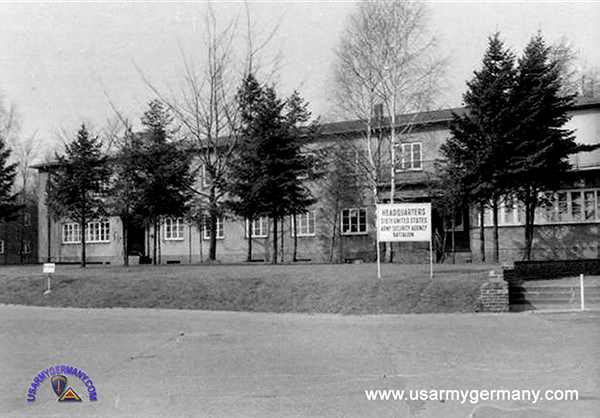 Headquarters, 319th USASA Battalion, Rothwesten Kaserne |
||||||||||||||||||||
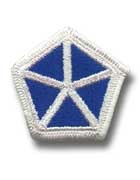 Patch worn by the 319th USASA Bn (Corps) Patch worn by the 319th USASA Bn (Corps) |
||||||||||||||||||||
| ANNUAL HISTORICAL REPORT - FISCAL YEAR 1958 (VOLUME 1) | ||||||||||||||||||||
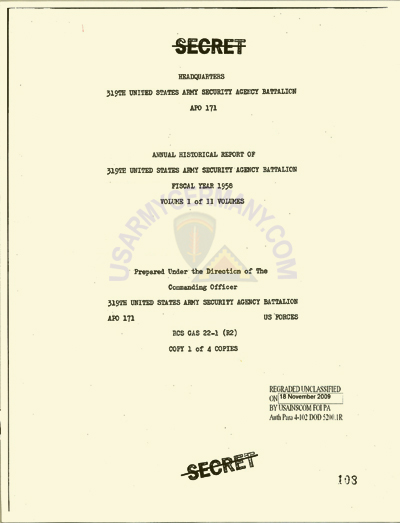 |
||||||||||||||||||||
 |
||||||||||||||||||||
| I have posted a scan of the 319th USASA Battalion Unit History (FY1958) that was recently declassified under FOIA. This is Volume 1 of 2. Vol. 2 was almost completed redacted and will not be presented here. The Appendixes for Vol. 1 was also withheld and is not posted. Other years and other ASA units to follow.... |
||||||||||||||||||||
| 1957 - 1971 | ||||||||||||||||||||
| (Source: A Short History of the 319th US Army Security Agency Battalion (Corps), 24 December 1951 - 1 June 1963 (with updates to 1971); submitted by Len Bittner) | ||||||||||||||||||||
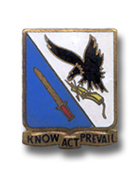 319th US Army Security Agency Bn DUI 319th US Army Security Agency Bn DUI |
||||||||||||||||||||
| On 15 October 1957, the 307th ASA Bn was deactivated and the 319th USASA Battalion formed from the officers and men of the 307th. The reorganization resulted in the addition of Company C, which was formed and located at Rothwesten. At the same time, the 184th US Army Security Agency Company was organized and assigned to the 319th USASA Bn. (Webmaster Note: Commanding Officer of 184th at that time was 1st LT Donald B. Bodenback, AS (Arty). The company was billeted near the mess hall in a building that was well down the slope of the hill. The Snack Bar, sick bay etc., were located at the top of hill. Personnel rode on a bus to the operations building which was separated from all other buildings.) During early 1958, a test team was dispatched from Rothwesten to determine the feasibility of opening an operational site in the Eschwege area. After the team's reports had been evaluated, it was decided to open such a site on Mt. Meissner. This was accomplished in September 1958 when a team from Company C and the 2nd Operations Platoon of the 279th USASA Company, which was attached to Headquarters Company of this battalion moved to the present location at Mt. Meissner. On 24 March 1959, the 2nd Operations Platoon of the 279th was assigned to Headquarters Company and the site at Mt. Meissner came under the control of Headquarters Company. This control was later assumed by Company C. (Webmaster Note: The 2nd Platoon of the 279th was an ELINT outfit [probably redesignated at some point as ELINT Platoon, C Co, 319th USASA Bn (Corps)] - equipped with the ESGX-3, later designated as AN/MLQ-24, that travelled the 5K zone to perform "threat" radar intercept and analysis.) On 12 August 1958, Company B moved its headquarters from Rothwesten to the operational site at Lübeck. This move shortened their command and supply lines as some of the facilities at the Port of Bremerhaven are utilized by Company B. On 1 October 1958, the 182nd USASA Company was attached to the battalion. (Webmaster Note: The 182d had formerly been designated the 339th ASA Company and had been largely manned by personnel from the Scheyern station. After the company was attached to the 319th, the 182d ASA Company also wore the V Corps patch. The 182d operations building was in the main "commons" area, across from the snack bar.) On 4 February 1959, Operations moved from the old building (now Kassel Sub-Post Headquarters) to its present location on the antenna field. (Webmaster Note: The new operations building was constructed in 1958 and was located in the middle of the antenna field. A few months prior to moving to the new building, the Hammerlund SP600's used by the unit were replaced with the new R390 receiver.) Renovation of the Heidwinkel Ammunition Area was completed during the spring of 1959, and on 4 April, Company A moved its headquarters from Rothwesten to Heidwinkel in order to be closer to its operational personnel. During March 1960, two additional operational sites, one at St. Andreasberg and one at Bad Sachsa, were opened and operated by personnel of Company C. On 1 July 1959, Major Paul Odonovitch, AS (Inf), assumed command of the Battalion from Col Rolle. On 9 August 1959, he relinquished command to Major Robert H. Campbell, Arty, who served as Battalion Commander until 20 August 1959, at which time Lt Col James L. Draper, Inf, arrived and assumed command of the unit. Reassignments during the spring of 1960 saw the 279th USASA Detachment attached to the battalion on 7 April and the 182nd USASA Company reassigned to the 318th USASA Battalion on 15 May. On 17 July 1960, Col Draper departed the command and Major Campbell again assumed command of the battalion until Lt Col Bryan Gruver, Jr., AS (Armor), arrived and assumed command on 1 August 1960. In November 1960, the battalion assumed responsibility for the Rothwesten Rod and Gun Club. On 7 April 1961, the 279th USASA Detachment was detached from the battalion, but remained in Rothwesten until July when it moved to Offenbach Kaserne. During July 1961, B Company personnel moved from the old houses on Jürgen-Wullenwever Strasse and Zwinglistrasse in Lübeck to the two new apartment houses on Blankenseer Strasse in Lübeck. Personnel and equipment located at Bad Sachsa integrated with the St. Andreasberg site and Bad Sachsa was closed down on 1 June 1962. On 25 June 1962, Major John J. Masters assumed command of the 319th from Col Gruver, who departed this unit for duty as Executive Officer of the 507th USASA Group. Major Masters conducted a farewell parade for Col Gruver on the antenna field at Rothwesten with representatives of all the units of the battalion participating. Command of the battalion passed to our present commander, Lt Col Eldon J. Burgett, AIS, on 19 July 1962. During the fall of 1962, facilities at Mt. Meissner were such that headquarters of Company C moved to that location in order to shorten their command lines. At the close of this history, the 319th USASA Bn (Corps) still has its headquarters at Rothwesten. However, this headquarters is merely the center of an area of responsibility that stretches from the Baltic Sea to Southern Germany and from near the Dutch border to the East-West German border. The battalion presently has sites at Lübeck, St. Andreasberg, Heidwinkel and Mt. Meissner as well as at Rothwesten. It has detachments at Handorf, Frankfurt, Würzburg, Darmstadt, and Bad Kreuznach. The distance between these sites and the headquarters poses a continuing problem, both in command and supply activities, but these problems will be solved as the other problems that the battalion has solved since its activation so that this unit may continue to serve, as it has in the past, in support of the US Army and the nation that is represented by that army. POSTSCRIPT On 21 June 1966, Company B, 319th USASA Battalion was redesignated as Company C, 318th USASA Bn and reassigned to the 318th. At the same time, Company C of the 319th was redesignated as Company B, 319th USASA Battalion. On 3 May 1971, the 319th USASA Battalion was discontinued as part of a major reorganization of the Army Security Agency in Europe which led to consolidation due to advances in technology and requirements to effect greater manpower and dollar savings. The Battalion was reorganized into the 326th ASA Co (Ops)(Fwd). The 326th ASA Co was act on May 3 1971 in (Augsburg,) Germany. |
||||||||||||||||||||
| 1961 | ||||||||||||||||||||
| (Source: Annual Historical Report of 319th US Army Security Agency Battalion, FY 1960, Vol 1) | ||||||||||||||||||||
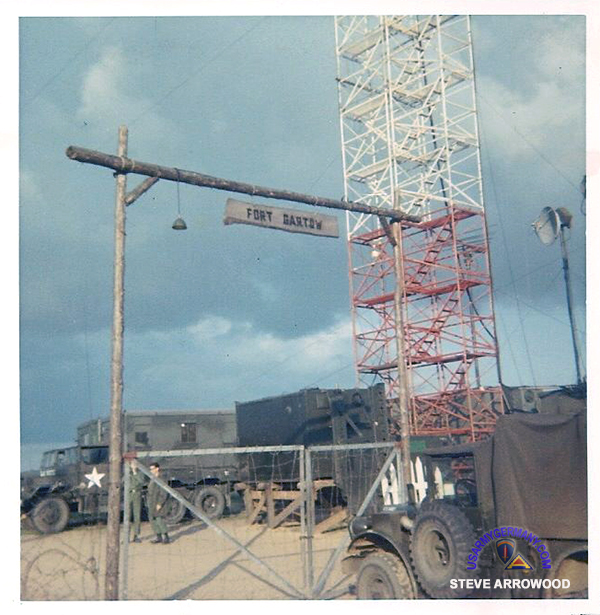 Entrance to Fort Gatow ASA site, around 1966 (Steve Arrowood, Rothwesten Kaserne FB) |
||||||||||||||||||||
| 1969 | ||||||||||||||||||||
| (Source: Email from Robert Harkness) | ||||||||||||||||||||
| I served in Company A of the 319th USASA Battalion from October 1969 through December 1970 as a 98G2L63. During this period I was assigned to Detachment L at Gartow on the border between East and West Germany. Lt. Col. Richard B. Blauvelt, MI, commanded the battalion at that time. Our job was to provide tactical intelligence to the Seventh Army about the Warsaw Pact forces, especially during their Summer and Winter exercises. As far as I know, we never wore any shoulder patch other than the standard ASA lightning bolt patch, even during deployment. We did wear the unit hat pin which had an eagle and a bayonet over the motto "Know, Act, Prevail".. I left Bad Aibling at the very beginning of October 1969. My orders were cut on October 3, 1969, and required me to report to Company A in Rothwesten by no later than October 15, 1969. I had my own car and left the next day early in the morning and drove all day arriving late that evening well after dark. While in transit, somehow the Army lost my records. I was assigned temporarily to the Unit Police for a couple of weeks at Rothwesten while a search was made for them. They eventually turned up a couple of months later. In the meantime, very shortly before the end of October, I was sent out to Detachment L at Gartow which was actually located in the woods on a hill overlooking a small village called Pevestorf. Our station was closer to Höbeck than Gartow. I was at Fort Gartow a very short while before being sent to a special transcriber school in the IG Farben building in Frankfurt. I was there from November 17 to December 12, 1969, before returning to Fort Gartow. I eventually became a trick chief and then was in charge of the transcription shop for about nine months before the end of my tour in December 1970. While serving at Fort Gartow, i lived in Pevestorf with the Roost family. Although I was a Russian linguist, I also spoke decent German, thanks to my Grandfather, and had a wonderful time on the border, though I had to quickly lose my Bavarian accent. |
||||||||||||||||||||
| 1970 | ||||||||||||||||||||
| (Source: Email from Rick Prescott, HHC 319th ASA Bn, 1970-71; 326th ASA Co, 1971-73; 201st ASA Co, 1979; 409th ASA Co; 204th MI Bn, 1987) | ||||||||||||||||||||
| Just a comment on your 319th ASA Battalion page. You have the V Corps patch showing for the patch the Battalion wore; that is only partially correct. The Battalion HQs and HHC wore the V Corps patch because during exercises (or real-world), that is who we deployed with to provide direct support. However, Alpha Company, 319th wore the 8th Infantry Division patch and Bravo Company, 319th wore the 3rd Armored Division patch because those are the elements they deployed with, and provided direct support to. All three companies were stationed at Rothwesten, but wore the three different unit patches. I was stationed with the 319th from April 1970 until we folded the Battalion Flag and moved down to Augsburg as the 326th ASA Company in late summer 1971. The 318th ASA Bn at Herzo Base was arranged similarly only their companies supported VII Corps, 3rd Inf Div, and 1st Armored Div respectively. They deactivated the 318th the same timeframe and they became the 2nd EW Company in Augsburg (within the 502nd ASA Gp - previously the 507th until the 1971 ASA Europe reorganization). I was in the HHC, Commo Platoon (72B Comms Center Specialist) so worked tactical landline comms in the field supporting the high side intelligence communications for the deployed V Corps HQs. In garrison, I manually published the Battalion SOI/CEOI and worked as COMSEC Custodian. We also had 05C RATT Operators and commo vans. I can't remember any operational assets that deployed with the Corps. I know the battalion had all the tactical standard SIGINT/EW equipment (i.e. MLQ-24, etc.), but I think most of that equipment deployed forward with A & B Companies directly supporting the Divisions. I should have caveated my email with "that's the patches worn while I was there" (1970-71) at the end of the Battalion's active life. I'm sure some of the Bn members from years before me probably wore completely different patches. There were no shortage of reorganizations back through the years. Once we moved down to Augsburg as the 326th ASA Company on Flak Kaserne, I believe the entire 502nd ASA Group wore the 7th Army patch. I served three separate tours in the same organization on Flak Kaserne. I was there Sep 1971 to Mar 1973 in the 326th ASA Company as an enlisted soldier. Went back in Sep 1979, initially assigned as OIC, Det G (SIGSEC Detachment), 201st ASA Co, 502nd ASA Bn supporting 3rd Armored Division in Frankfurt, then shortly after the 533rd CEWI Battalion activated, I moved back down to Augsburg as XO, Opns Officer, and then Commander for the 409th ASA Co (HF Intercept & DF) which was the Operations Company for the 502nd ASA Bn. I then went back to Augsburg in 1987 for a third tour as the S3 in the 204th MI Bn (previously the 502nd ASA Bn). I probably have more history in that organization than any one else that I know. Thanks for taking the time to initiate and maintain the website. |
||||||||||||||||||||
| Company "A" 319th ASA Bn | ||||||||||||||||||||
| (Source: Email from Jeff Geoffrion, Co "A" 319th ASA Bn, 1965-67) | ||||||||||||||||||||
|
||||||||||||||||||||
| Company "B" 319th ASA Bn | ||||||||||||||||||||
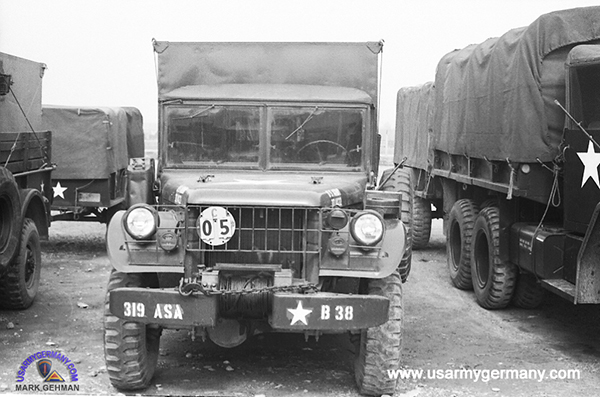 One of the ASA detachment's vehicles at Flak Kaserne, around 1965. |
||||||||||||||||||||
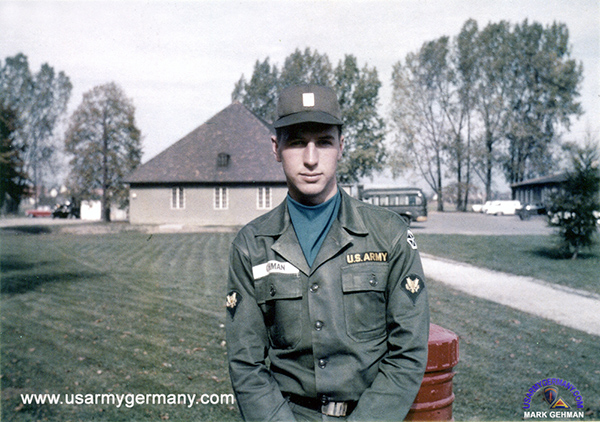 Mark Gehman at Flak Kaserne still wearing the V Corps patch. Bldg #203 in the background. |
||||||||||||||||||||
| (Source: Email from Mark Gehman, Co "B" 319th ASA Bn, 1965-67) | ||||||||||||||||||||
| I was a member of a 16-man ASA unit embedded with the 24th Infantry Division in Augsburg. I worked with the 24th from March 1965 until May 1967. We shared the 3rd floor in the Division headquarters building with the Commanding General. Initially, we were a detachment of the 319th USASA Battalion in Kassel and wore the V Corps patch (see photo above). At some point we were reassigned to the 318th USASA Bn and replaced the V Corps patch with that of the 24th Inf Div. Our mission was secret and we kept a low profile. Some information about Flak Kaserne that I remember: - The divisions comm center was located in the basement of the Headquarters building. - HHC, 24th Inf Div was located on the second floor of the Headquarters building and they provided some office space to us. - The Snack Bar, PX were located in Bldg 203. - Division S-2 was located in Bldg 202. (I believe the Education Center was in that building also.) - The EM Club and mess hall were located in Bldg 210. |
||||||||||||||||||||
| 182nd ASA Company | ||||||||||||||||||||
| 1958 | ||||||||||||||||||||
| (Source: ttached to the 319th ASA B) | ||||||||||||||||||||
| The 182nd ASA Co had formerly been designated the 339th ASA Company and was been largely manned by personnel from the station at Scheyern. On Oct 1 1958 the company was attached to the 319th ASA Bn. On May 15 1960 the company was relieved from attachment to the 319th and attached to the 318th ASA Bn in Herzogenaurach. |
||||||||||||||||||||
|
||||||||||||||||||||
| (Source: Email from Mark Rubin) | ||||||||||||||||||||
| My name is Mark Rubin and my late father, Robert Rubin, served in the USASA unit 182nd in Germany, 1958-62. Sadly he passed away before he could tell me anything meaningful about his service, he said he was sworn to secrecy and passed when I was very young. He mentioned a lot of driving big trucks around and listening to the radio which all makes perfect sense. I have no information I can add to your site, aside from these two photos from our family archive. One of the unit’s sign and another of my father in the barracks. He said he spent a lot of his time in Berlin and he spoke German in the Berliner accent. He said he had been to school to learn Russian and Romanian as well. Would love to hear from anyone who served with him. |
||||||||||||||||||||
| (Source: Email from Rob Plain, 182nd ASA Co, 1958) | ||||||||||||||||||||
| I read with interest the email written by John Meekens regarding FS Rothwesten. He makes mention of a strike which took place there by the 058's. I was at Rothwestern when that occured in 1958 while we were still in the old operations building. The unit involved was the 182nd ASA Co. The reasons for the strike was basically we had a poorly diciplined and a poorly run company which was under the command of a Capt. The strike occurred over a two day period and ended when an armed CO gave each operator a direct order to go back to work. There was a rather intense investigation by the Army which resulted in each operator being interview for several hours. We also were interview by the IG. The captain in question was relieved of his command and replace by a field-grade major whose name I can't recall. When the recommendations for court martial were forwared to the major, he supposedly stated that if the Army would not court martial every man in the company, he would not allow the court martial of a single one. No one was ever disciplined and conditions did improve. Probably another factor was that dozens of personnel wrote their senators which resulted in a smaller investigation by the Air Force ("owners" of the installation.) |
||||||||||||||||||||
| 184th ASA Company | ||||||||||||||||||||
| (Source: Email from Wayne Gay, 184th ASA Co, 1957-1959) | ||||||||||||||||||||
| I was scrolling through the website and enjoyed reading all of the information. Here is a little history of my tour of duty: I enlisted in the Army Security Agency in Nov. 1956 and after Basic in Ft. Leonard Wood, Mo. was sent to Ft. Devens, Mass. for processing. After tests myself and some 20 or more were then sent to Ft. Gordon, Ga to High Speed Radio School. MOS 052. After graduating we were sent back to Ft. Devens for MOS 201, Communications Countermeasures. After graduation we then were shipped to Germany except to two people who went to Ft Huachuca, AZ. A PFC Hill and PFC Hardin. After processing in Frankfurt they split our group into two parts and some of us went to Rothwesten and the rest went to Herzo. The ones in Rothwesten were assigned to the 184th USASA CO. Maj. John Kelton was the CO (He was a Capt. then and was promoted to Major later.) M/Sgt Cromley was the first sgt. The 201 MOS detachment would go in the field with other Army Units during their training and maneuvers. After Sabre Hawk in Feb. 1958 Sgt. Cromley asked me if I wanted to be his Company Clerk. I took the job. I didn't particularly like camping out in the winter. Soon after I took the job, Sgt Cromley was promoted to E-8 and transferred to the 507th Grp. HQ. MSgt Donald Fields replaced him was our 1st Sgt until I left in November, 1959. I was in the 184th from Nov. 1957-59. We recently had a small reunion in Branson, Mo for some of the guys that were with me at the 184th. Myself, (Wayne Gay), Jerry Grassel, Jerry Reynolds, Leonard Lee, Leonard Plucinski, Joe Butler, Billy Stockton, John Schmidt. Jerry Grassel and Jerry Reynolds and Leonard Plucinski, Leonard Lee were in Comm. Billy Stockton took a job as Mail Clerk and Driver and Company Clerk. (A man for all seasons). Joe Butler and John Schmidt worked in Supply. John was orginally in the 201 unit as was myself and Billy Stockton. Also with me in the clerks office was Lucian Rarogiewicz who passed away this past June. (2007). I have a lot of good memories of my duty in Rothwesten and around Kassel, Germany. We got to travel all over Europe, (Italy, France, Spain, Austria, Belgium, Holland And Luxembourg.) Anyone wanting to contact me can at my e-mail address. My brother, Paul E. Gay (deceased), was stationed at Bad Aibling, Germany at about the same time -- 181st USASA Co, 1956-58. |
||||||||||||||||||||
| (Source: Email from Neil Piercey, 184th ASA Co and 182nd ASA Co, 1958- ) | ||||||||||||||||||||
| After completing basic training and 056 training at Ft. Devens, I was assigned to the 184th ASA Co, Rothwesten in 7-58. Our barracks was a large 2-story building that was on the down slope of a hill on the post. This building housed our orderly room, efficiently run by 1st Sgt Fields, our quarters, mess hall supply room and armory. Operations was in a large 2-story building at the top of the hill. The new operations building in the antenna field was under construction. My job as a newbie was to walk around the 058s, pick up missions and hand flash them to the SIT Section (Special Identification Techniques) in the back of the room (056s and one 057), who would then send the missions out to the outstations. I hated this job, begged and pleaded to be sent to one of our outstations at Lübeck or Bremen. SIT stood for Special Identification Techniques and consisted of RDF (Radio Direction Finding) (056) and RFP (Radio fingerprinting) (057). We were incorporated into a Platoon of the 184th, whenever we were stationed with the company. A platoon consisted of 058s, 056s, 057s, 059s, and a couple of voice intercept operators (MOS #?), as well as cryptographers, RDF plotters and RFP analysts. However, when we were at an outstation, we were not assigned to a platoon, but reported directly to the SIT NCOIC and SIT OIC. I don't recall any 056 assets being assigned to any other section of the 184th. When I first arrived at the 184th, there were only 2 DF sites, Luebeck and I thought the other was at Bremen. I have never heard of Handorf, however, it could have been a smaller town outside of Bremen, and Bremen was always mentioned due to its geographical size. Because there were only two, that was the reason that a third was set up at Fritzlar. In order to get a triangulation, sites of the 182nd had to respond to our missions. I did not know of a second DF site out of the 182nd. I do know that at least one site in Italy was used for triangulation for their missions. Geography can help with the understanding of the missions at that time. I do not recall the 184th having a field station operations other than the SIT mission. I corresponded with a friend who spent his entire 2 year tour at Rothwesten as an 059, and he does not recall any other field station operations. After a few months, a decision was made to set up an experimental outstation at Fritzlar. We were the only G.I.s in Fritzlar, except for 3 or 4 guys who were a liaisons with the German armored unit stationed there. We lived in a hotel, and at all of our meals at the hotel. There were only 9 or 10 of us and we were the only residents of this small hotel. We had one Sgt as Site NCOIC, whose name I can not recall. Our site chief was Sp5 Mellish. I was teamed up with Sp4 Frank Campbell. This was real tough duty! However, the powers that were decided to close the site after a few months. Their decision was probably made easier by our shenanigans. SIT NCOIC was Sgt 1st Class Kelly, an ex WWII paratrooper, who was sharp as a tack. He could chew you out for one hour and never repeat himself or lose his voice. Between him and 1st Sgt Fields I got my share of yelling. By this time, I had completed my first year of duty in Europe. I was then transferred to the 182nd ASA Co, at Herzo Base. I was immediately given an assignment to an outstation in Giebelstadt. We lived on a small Air Force base, and were supported with housing, rations, fuel, etc. by the Air Force. The purpose of this Air Force unit was to support the U2 spy plane. We could look out our barracks window and watch the U2 land and take off. Our site was off base and the Air Force pretty much left us alone. To make it even better, I became friends with some of the APs, who would get me out of trouble with the local police occasionally. At Gieblestadt, I was reunited with some of my friends from basic training (Ft. Chaffee, Ar) and Devens. The one name that I can recall is Kenneth Eaton. Duty in Germany for an 056 was good duty, I was tempted to extend, but decided to go back to school. In one year, I was married, and broke, with no job, so I re-enlisted. My second hitch was in Korea, 177th ASA Co., and Ft. Wolters, TX, 330th ASA Co. 2 hitches was enough, but I still miss the ASA and all of my friends that I made. |
||||||||||||||||||||
| Related
Links Wurmberg - nice page on the ASA site at Wurmberg. Page is hosted on the German website - LostPlaces.de Gatow and Wobeck - nice page on the ASA sites at Gatow and Wobeck. Great photos of the Torii Towers!! Page is hosted on the German website - LostPlaces.de ASA Veterans Reunions - a guestbook that specializes in organized ASA reunions. |
||||||||||||||||||||
|
||||||||||||||||||||

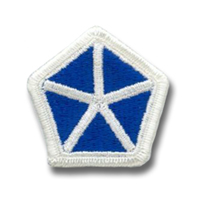
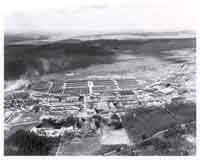
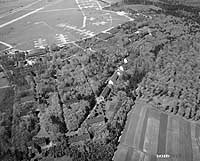
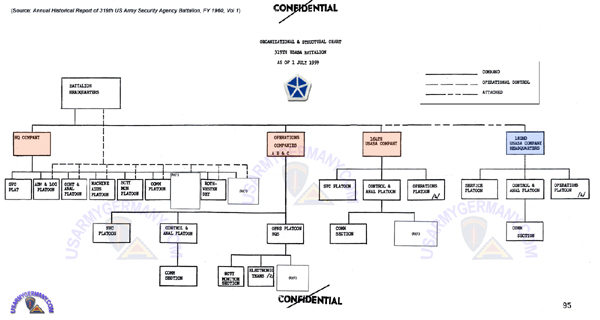
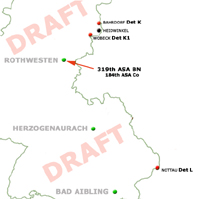
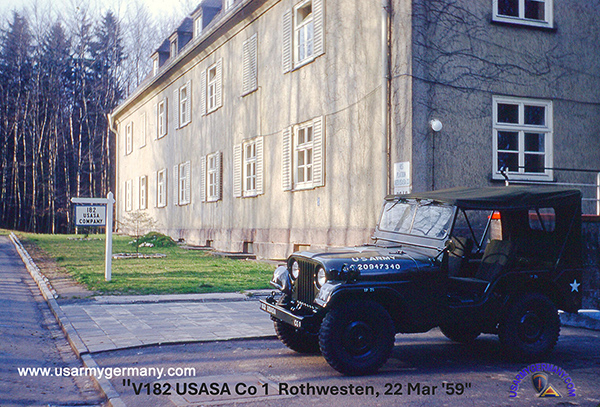
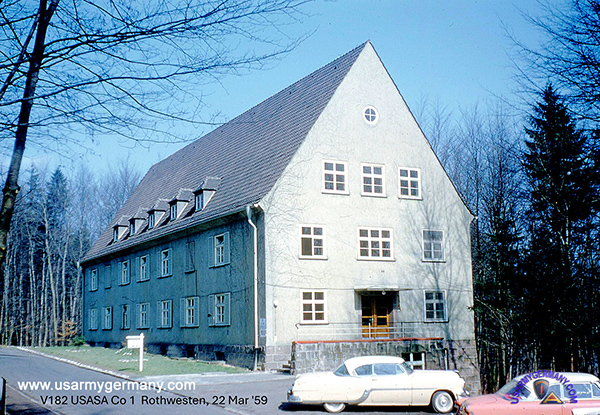
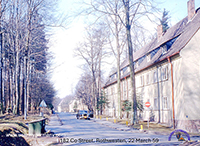
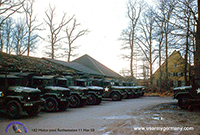
 late 1950s - Mark Rubin).jpg)



